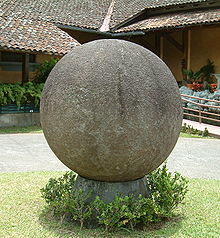Stone spheres of Costa Rica


The stone spheres (or stone balls) of Costa Rica are an assortment of over three hundred petrospheres in Costa Rica, located on the Diquis Delta and on Isla del Caño. Locally, they are known as Las Bolas. The spheres are commonly attributed to the extinct Diquis culture and are sometimes referred to as the Diquis Spheres. They are the best-known stone sculptures of the Isthmo-Colombian area.
Description
The spheres range in size from a few centimetres to over 2 metres (6.6 ft) in diameter, and weigh up to 15 tons.[3] Most are sculpted from gabbro,[3] the coarse-grained equivalent of basalt. There are a dozen or so made from shell-rich limestone, and another dozen made from a sandstone.
Pre-Columbian history
The stones are believed to have been carved between 200 BC and 1500 AD. However the only method available for dating the carved stones is stratigraphy, and most stones are no longer in their original locations. The culture of the people who made them disappeared after the Spanish conquest.[4]
Spheres have been found with pottery from the Aguas Buenas culture (dating 200 BC – AD 600) and also they have been discovered with Buenos Aires Polychrome type sculpture (dating 1000 – AD 1500).[5] They have been uncovered in a number of locations, including the Isla del Caño, and over 300 kilometres (190 mi) north of the Diquis Delta in Papagayo on the Nicoya Peninsula.
Post-contact history
The spheres were discovered in the 1930s as the United Fruit Company was clearing the jungle for banana plantations.[4] Workmen pushed them aside with bulldozers and heavy equipment, damaging some spheres. Additionally, inspired by stories of hidden gold workmen began to drill holes into the spheres and blow them open with sticks of dynamite. Several of the spheres were destroyed before authorities intervened. Some of the dynamited spheres have been reassembled and are currently on display at the National Museum of Costa Rica in San José.
The first scientific investigation of the spheres was undertaken shortly after their discovery by Doris Stone, a daughter of a United Fruit Co. executive. These were published in 1943 in American Antiquity, attracting the attention of Samuel Kirkland Lothrop[6] of the Peabody Museum at Harvard University.[7] In 1948, he and his wife attempted to excavate an unrelated archaeological site in the northern region of Costa Rica.[8] The government of the time had disbanded its professional army, and the resulting civil unrest threatened the security of Lothrop's team. In San José he met Doris Stone, who directed the group toward the Diquís Delta region in the southwest ("Valle de Diquís" refers to the valley of the lower Río Grande de Térraba, including the Osa Canton towns of Puerto Cortés, Palmar Norte, and Sierpe[9]) and provided them with valuable dig sites and personal contacts. Lothrop's findings were published in Archaeology of the Diquís Delta, Costa Rica 1963.
In 2010 University of Kansas researcher John Hoopes visited the site of the Stone Spheres to evaluate their eligibility for protection as a Unesco World Heritage Site.[10]
Myths
Numerous myths surround the stones, such as they came from Atlantis, or that they were made as such by nature. Some local legends state that the native inhabitants had access to a potion able to soften the rock. Research led by Joseph Davidovits of the Geopolymer Institute in France has been offered in support of this hypothesis,[11] but it is not supported by geological or archaeological evidence. (No one has been able to demonstrate that gabbro, the material from which most of the balls are sculpted, can be worked this way.)
It has been claimed that the spheres are perfect, or very near perfect in roundness, although some spheres are known to vary by 5 centimetres (2.0 in) in diameter. Also the stones have been damaged and eroded over the years, and so it is impossible to know exactly their original shape. A review of the way that the stones were measured by Lothrop reveals that claims of precision are due to misinterpretations of the methods used in their measurement. Although Lothrop published tables of ball diameters with figures to three decimal places, these figures were actually averages of measurements taken with tapes that were nowhere near that precise.[12]
See also
- Carved Stone Balls of Scotland, UK
- Petrosphere
- Stone ball
- List of megalithic sites
- Olmec colossal heads
References
- ^ Fabio Mena. La Prensa Libre: Significado de la Plaza de la Justicia, 2007
- ^ M. A. C. (2012-03-05). "Costa Rica inaugura la escultura más alta del país". CRhoy.com Noticias 24/7. Retrieved 2012-07-25.
- ^ a b "The stone spheres of Costa Rica". BBC News. 29 March 2010. Retrieved 2010-03-31.
- ^ a b Brendan M. Lynch (22-Mar-2010). "University of Kansas researcher investigates mysterious stone spheres in Costa Rica". Retrieved 2010-03-24.
{{cite news}}: Check date values in:|date=(help) - ^ John W. Hoopes. "The Stone Balls of Costa Rica". Retrieved 2007-06-19.
- ^ National Academy of Sciences (1877). "Samuel Kirkland Lothrup". Biographical memoirs, Volume 48. National Academies Press. p. 399.
{{cite book}}:|access-date=requires|url=(help); External link in|chapterurl=|chapterurl=ignored (|chapter-url=suggested) (help) - ^ Tim McGuinness. "Costa Rican Diquis Spheres: Sphere history". mysteryspheres.com. Retrieved 2010-03-31.
- ^ Eleanor Lothrop (September 1955). "Prehistoric Stone Balls—a Mystery". Picks from the Past. Natural History. Retrieved 2010-03-31.
- ^ Gazetteer of Costa Rican Plant-Collecting Locales: Diquís (or Dikís) from the website of the Missouri Botanical Garden
- ^ "The stone spheres of Costa Rica". BBC News. 2010-03-29. Retrieved 2010-09-12.
- ^ Joseph Davidovits. "Making Cements with Plant Extracts" (PDF). Retrieved 2010-08-13.
- ^ John W. Hoopes. "Errors and Misinformation". Retrieved 2007-06-19.
External links
- Stone Spheres, Diquis Delta, Costa Rica from Landmarks Foundation
- Costa Rican Stone Spheres, a website by archaeologist Tim McGuinness, Ph.D.
